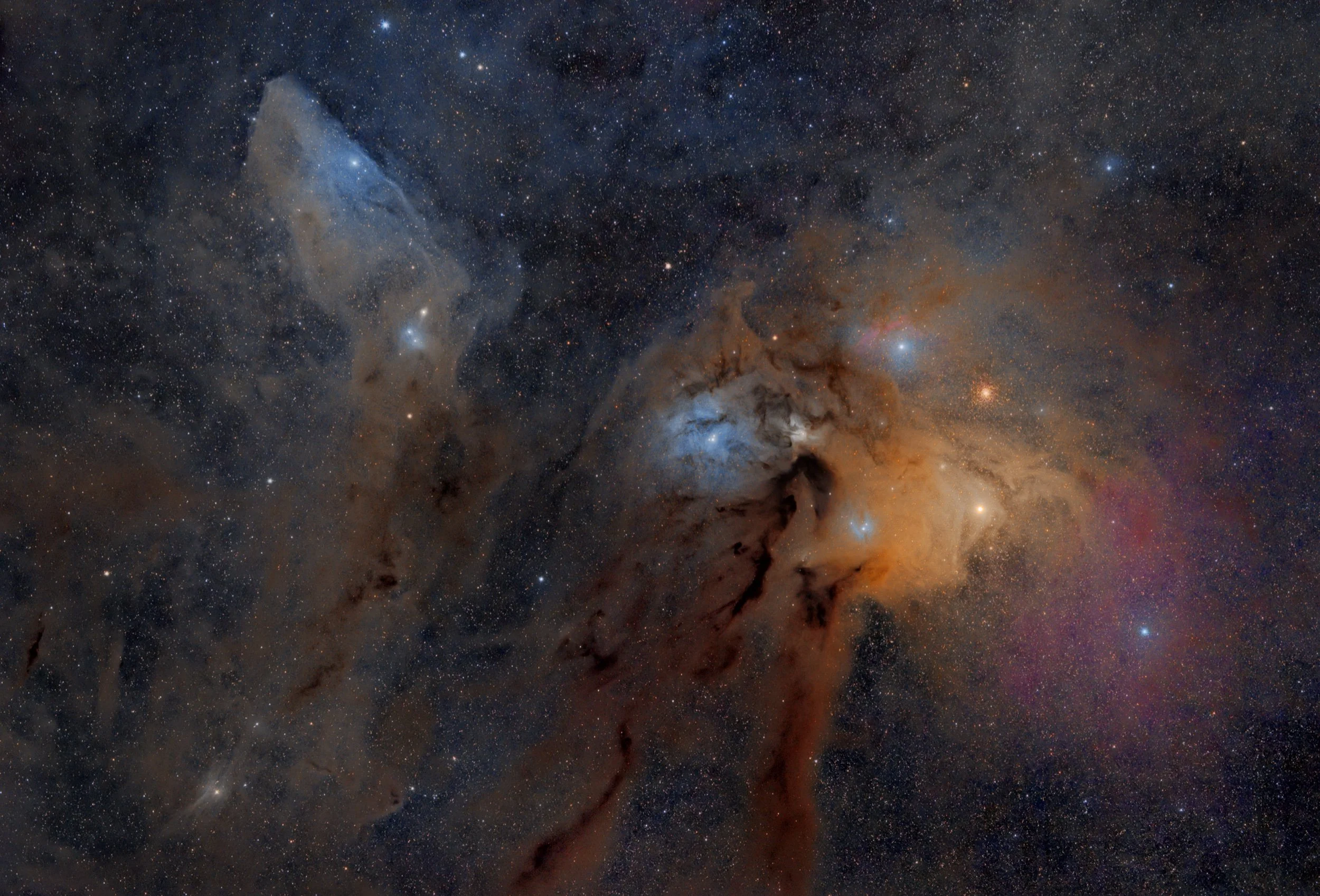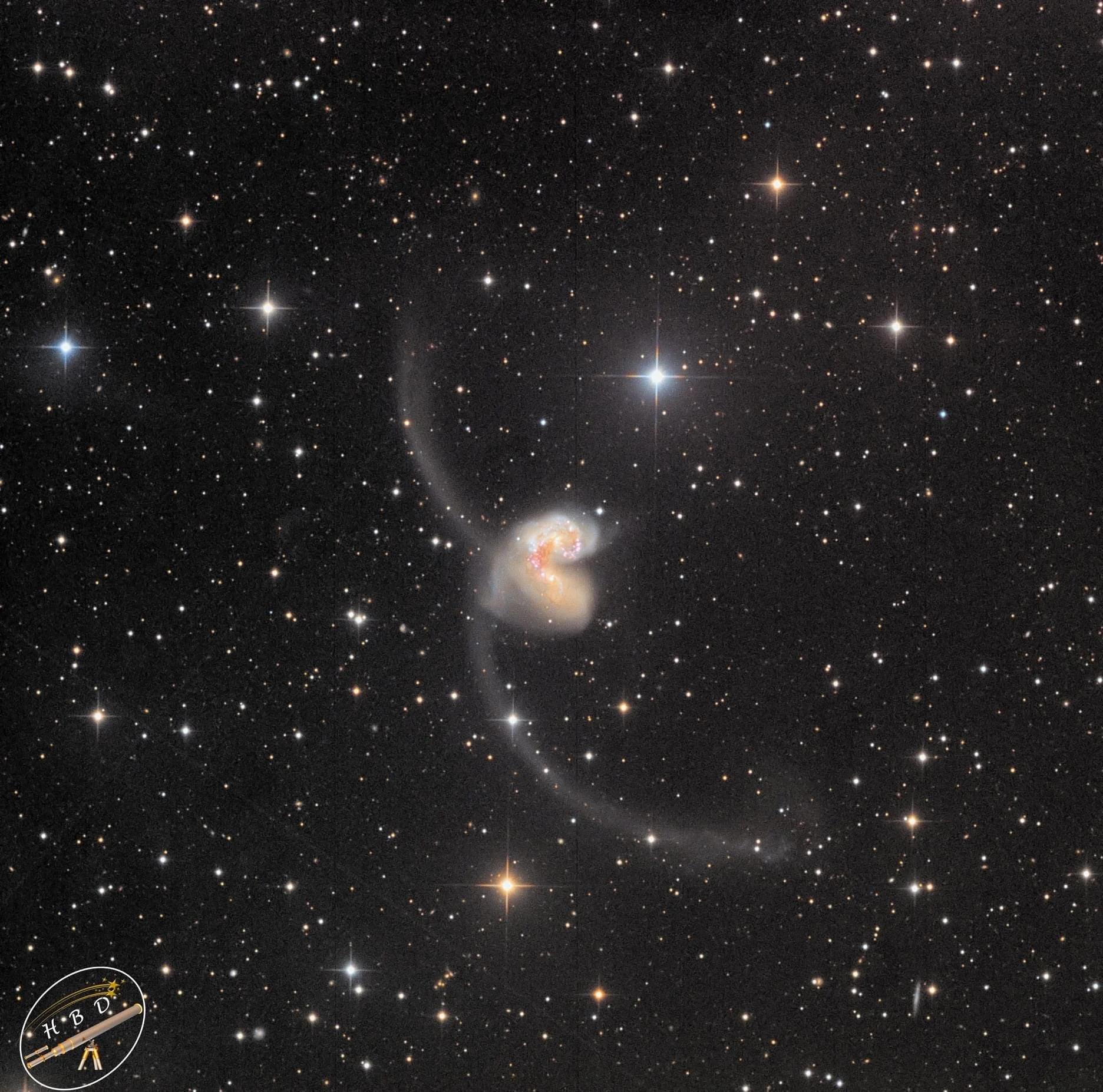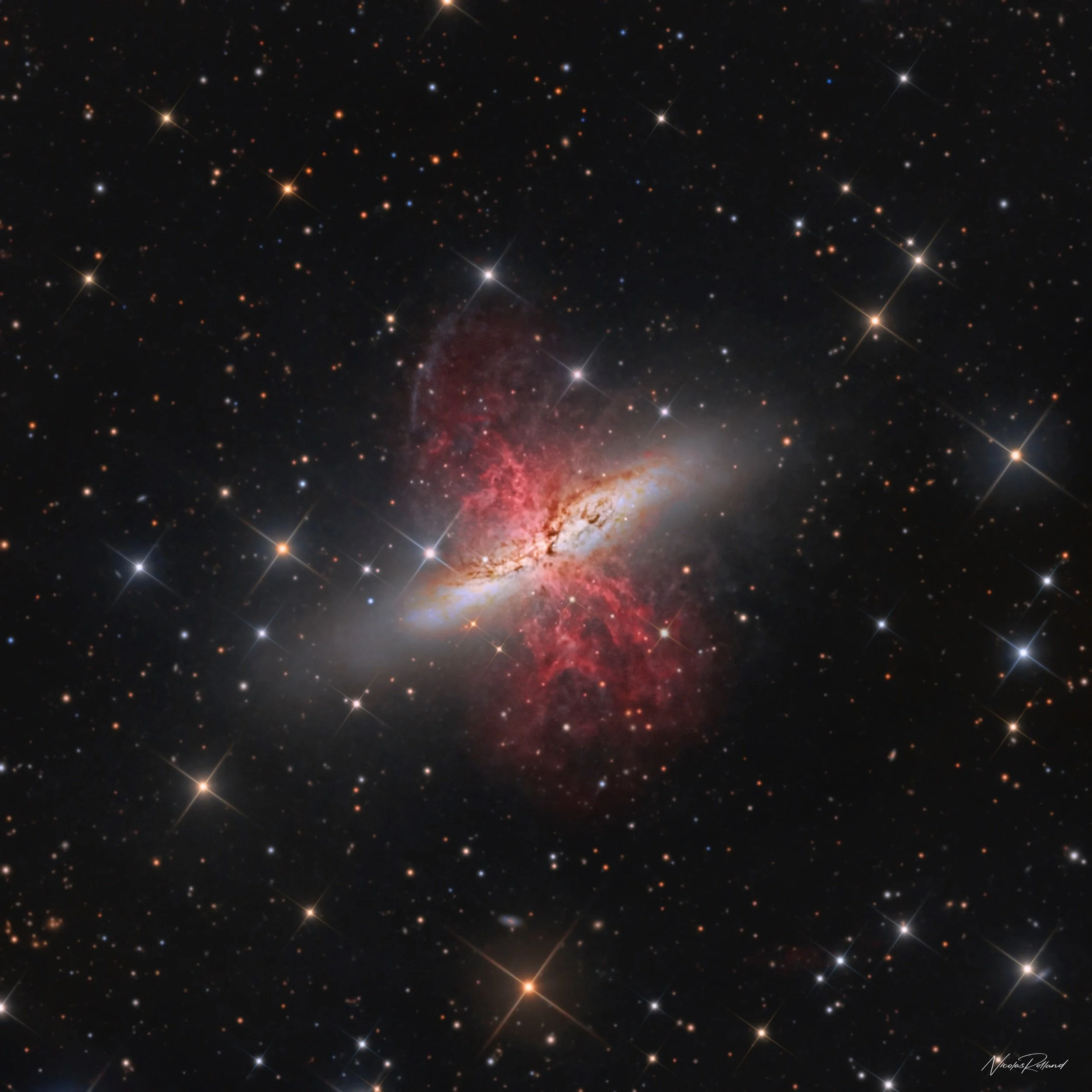
AAPOD2 Image Archives
SH2-240 Spaghetti Nebula
Image Description and Details :January/February 2022
Location: San Romualdo - Ravenna (Italy)
Samyang 135mm F/4 on Avalon M1
Celestron OAG with QHY5III 174M
QHY294C cooled -25 - Optlong L-Extreme filter - 111x10' images
ASI294C - Optlong L-Extreme filter 72x5min. images
Acquired with: SharCap - Calibrated with Dark and Flat
Processed with: DeepSkyStacker4, MaximDL5, Astroart8, Startools1.8, Paint Shop Pro2021, plug-in Topaz and Nik.
Copyright: Cristina Cellini and Paolo Baldoni
Flaming Star to Simeis 147
Image Description and Details :
This image shows the area of sky above the constellation of Orion. In the top right, looking like a comma is the Flaming Star Nebula. Just to the left of it is the Tadpole Nebula. If you look at the high resolution image on my website you can see the tadpole shaped structures inside it that give it its name. To the upper left is Sharpless 232 which I always think looks like a person running in a hamster wheel! To the bottom left is the large supernova remnant Simeis 147 aka the Spaghetti Nebula. This is a 16 image mosaic taken at a focal length of 530mm with a 4 inch refractor. 171 hours of light was collected through H-alph, SII and OIII filters.
Copyright: Alistair Symonu
IC1396 The Elephant's Trunk Nebula
Image Description and Details : Imaging Telescopes Or Lenses: Stellarvue SV105-3FT
Imaging Cameras: ZWO ASI294MM Pro
Mounts: Astro-Physics Mach2GTO
Filters: Chroma Ha 31mm 3nm · Chroma OIII 31mm 3nm · Chroma SII 31mm 3nm
Accessories: ZWO ASI OAG
Software: StarKeeper.it Voyager · Pleiades Astrophoto PixInsight 1.8 Ripley · Open Guiding PHD 2.6.2 · StarNet++
Guiding Telescopes Or Lenses: Stellarvue SV105-3FT
Guiding Cameras: ZWO ASI 120MM Mini
Acquisition details
Frames:
Chroma Ha 31mm 3nm: 86x300" (7h 10') bin 2x2
Chroma OIII 31mm 3nm: 100x300" (8h 20') bin 2x2
Chroma SII 31mm 3nm: 130x300" (10h 50') bin 2x2
Integration: 26h 20'
Copyright: Chad Andrist
The Antares Rho Ophiuchus Region
Image Description and Details : Equipment:
Stock Nikon Z5 and Stock Nikon D5600
Samyang 135 f2 lens at f2.8
iOptron Skyguider Pro
Sub length: 90, 120 and 135s subs across 11 sessions.
Total Integration time: 9 hours 15mins
Processed in Pixinsight and Photoshop.
Shot under Bortle 1 Skies in Spiti, India.
Copyright: : Shikhar Gupta
Three Clusters in Puppis
Image Description and Details :
Three open star clusters are seen here in the constellation Puppis, east of the bright star Sirius. To the lower left is Messier 46 or M46, 5000 light years away. M46 has about 500 stars estimated to be about 250+ million years old. The planetary nebula NGC 2438 lies on the northeast edge of M46 (about the 11 o’clock position in the image) but is most likely not part of the cluster.
Just one degree west-northwest of M46 (to the right in the image) lies another open star cluster Messier 47 or M47. M47 is much younger in age, about 78 million years old and is 1600 light years distant. There are also about 500 stars, mostly high temperature giant blue stars, reflecting the cluster’s young age, as well as some red giants.
NGC 2423 is the open cluster just above M47 in the image and is much closer to us. It contains several red giant stars, at least one of which has an orbiting planet discovered in 2007. The distance to that system is about 2500 light years.
Capture info:
Location: Orion’s Belt Remote Observatory, Mayhill NM
Telescope: Takahashi FSQ 106N
Camera: SBIG STXL 16200
Mount: Paramount MX+
Data: RGB 3,2,2.5 hours
Processing: Pixinsight 1.8.8.7
Copyright: Dave Doctor
K2-1
Image Description and Details :
K2-1
A very faint and obscure planetary nebula some 3700 light years away in the constellation Auriga.
Initially catalogued as a planetary nebula, was later thought to be misclassified and considered to be either a reflection nebula (LBN 809), an H-II region, and even a galaxy (PGC 16765). However it has recently been rediscovered as a genuine planetary nebula. It has a size of 115x126 arc seconds and is predominantly OIII. The weaker Ha signal has a similar form to the OIII signal. However there's an odd small area of red nebulosity at the top left-hand corner. This is possibly some NII emission which would be captured by the 5nm bandwith of my Ha filter (the spectrum shows that NII is present).
Discovered by Czech astronomer Dr. Luboš Kohoutek in 1962 by visually examining the National Geographic Society-Palomar Observatory Sky Survey prints at the Astronomical Institute in Prague, Czech Republic
It has a mean surface brightness of 24.1 mag/arc sec.
Image captured on my remote dual rig at Fregenal de la Sierra in Spain between 19-23 February 2022.
Scopes: APM TMB LZOS 152 Refractors
Cameras: QSI6120wsg8
Mount: 10Micron GM2000 HPS
A total of 37 hours image capture (HaOIIIRGB)
Copyright: Peter Goodhew
Dark nebulas of Chamaeleon
Image Description and Details :
The dark nebula complex in the constellation of Chamaeleon emits a brown hue in the image due to its strong red and near-infrared colors. The the bright star Beta Chamaeleontis is visible just to the right of center with the dust that surrounds it preferentially reflecting blue light from its primarily blue-white color. Beta Chamaeleontis, latinized from β Chamaeleontis, is the third-brightest star in the southern constellation of Chamaeleon, approximately 298 light years away from sun. The star has five times the mass of the Sun and 2.8 times the Sun's radius.
All of the pictured stars and dust occur in our own Milky Way Galaxy with - but one notable exception: the white spot just below Beta Chamaeleontis is the galaxy IC 3104 which lies far in the distance.
Scope: Takahashi FSQ-106ED
Mount: Paramount MX+
Camera: FLI PL16083
Astrodon Ha (3nm) & OIII (3nm)
Total Integration Time: 1 hrs. 30 min (HA: 5 x 600 sec, OIII: 4 x 600 sec)
Post Processing: Deep Sky Stacker, Pixinsight, Photoshop
Copyright: Basudeb Chakrabarti
Two towers of plasma in the Sun
Image Description and Details :
This morning, February 18, I photographed this magnificent prominence on the northeast limb of the sun. These two towers of hot plasma rise more than 90,000 km above the sun's surface.
On the solar disk, not many sunspots are seen but many filaments in multiple active regions are very noticeable.
To take this picture I used a Coronado Solarmax II 90mm telescope and a ZWO 183MM camera.
Copyright: Eduardo Schaberger Poupeau
California Nebula NGC 1499 SHO
Image Description and Details : Skywatcher Esprit 120ED Super APO Triplet
ZWO ASI294MM Pro ZWO
Skywatcher AZ EQ6 GT
Chroma OIII 3nm 36mm · Chroma SII 3nm 36mm · Chroma HA 5nm 36mm
N.I.N.A. · Pleiades Astrophoto Pisinsight 1.8
Chroma HA 5nm 36mm: 25x600" (4h 10') (gain: 200.00) -10C bin 1x1
Chroma OIII 3nm 36mm: 20x600" (3h 20') (gain: 200.00) -10C bin 1x1
Chroma SII 3nm 36mm: 20x600" (3h 20') (gain: 200.00) -10C bin 1x1
Integration:
10h 50'
Darks:
50
Copyright: Jose Luis Bedmar
M51 HaLRGB
Image Description and Details :
The Whirlpool Galaxy is a classic spiral galaxy. Known as M51 and NGC 5194, this galaxy may have been the first galaxy for that identified spiral structure. It is located at a distance of 30 million light years from the Sun. Measuring 60,000 light-years across, it is one of the brightest and most beautiful galaxies in the sky. The Whirlpool Galaxy can be seen with good binoculars in the constellation Canes Venatici. The M51 galaxy belongs to the Sc type spiral galaxies and is the main member of a whole group of galaxies. Astronomers suggest that the appearance of the spiral structure of the galaxy M51 is mainly due to the gravitational influence of a small satellite galaxy NGC 5195.
Also in the picture, next to M51, you can see the galaxies IC4277, IC4278 plus many small galaxies in the background.
This image was originally intended to capture an extragalactic hydrogen cloud near M51. However even 22 hours of exposure through the Ha filter gave no hint of it.
Own remote observatory, 50 km from Kiev, Bortle 4 zone. Imaged during February - June 2021. AZ-EQ6 mount, ONTC8 newton, QHY22. Guide - OAG with Lodestar camera.
Astrodon 5nm Ha: 88 x 900s;
Astrodon L: 228 x 300s;
Astrodon R: 40 x 300s;
Astrodon G: 40 x 300s;
Astrodon B: 70 x 300s;
Total exposure - 53 hr.
Captured in SGP, processed in Pixinsight.
Copyright: Sergiy Vakulenko
Plato and the lunar Alps
Another sunrise, this time over Plato and the lunar Alps. Mewlon 250CRS, 1.8x barlow, ASI290MM camera.
Another sunrise, this time above Crater Plato and the moon Alps . Mewlon 250CRS, 1.8xbarlow, ASI290MM camera .
Copyright: Dominique Dierick
Antennae Galaxies
Image description:
In the constellation of Rabe we see an interesting process, the merger of the galaxies NGC 4038 and 4039. This interaction will cause a rapid star eclipse. The same fate will happen in the distant future when Andromeda Galaxy and Milky Way collide. Here it is in 66 million Lj distance for us just a play in the cosmos.
Setup: Planewave CDK, 60 cm, f 6,5
Kamera FLI PL 9000 mit Filterrad, 3056×3056 px
Processed in LRGB with Fitswork, PixInsight and PS
Copyright: Hans Dorfeldt
NGC 2170 and others
Image Description and Details :
NGC 2170 nebular complex in Monoceros. L Ha RGB exposure for about 21 hours. Scope GSO RC 30 cms, camera Sbig STF8300-AO/8, from my backyard obs at La Colonia, Illapel, Chile. Suburban skies. All exposures at -35°C, all subframes 12 minutes except Ha (16 minutes each). MaxIm, CCDStack2, Photoshop softwares.
Name: Pedro Goles
The Giant Vs. The Mighty
Image Description and Details :
This shows the huge Seagull Nebula, and the very small (in comparison) but bright Thor’s Helmet Nebula, in narrowband.
This is an image 2 years in the making. I spent 10 full nights on imaging the Seagull Nebula wide field, as I also wanted to include Thor’s Helmet in the frame. I then added an extra 2 nights worth of data using a larger telescope on Thor’s Helmet only. This allowed me to get a nicer view on that target. All the data acquired was by myself with my own gear.
The Seagull Nebula is known as IC 2177. It is a large nebula that can be found 3,650 light-years away in Monoceros. It is a great target for both broadband and narrowband imaging, and is very close to the much smaller Thor's Helmet Nebula.
If you look closely near the Oxygen gases of the Seagull Nebula, you should be able to spot a bright star with a strange arc-shaped line of gas just above it. This is commonly known as the "Bow shockwave" in IC 2177. It is believed to come from the interaction between the interstellar dust within the nebula, high radiation winds, and gas expelling from the double star system "FN CMa”. The exact origin is still not very clear, but we might learn more about it in the years to come!
Thor’s Helmet is known as NGC 2359. It is a cloud of interstellar gas, although very faint, the colors in the gases really pop when taking long exposure shots with any camera.
This beautiful deep-sky object gets its glow from WR7, a massive Wolf-Rayet star that will soon turn into a supernova.
This is a total of 61 hours of exposure, a record for me as my longest acquisition so far was 48 hours. I captured 99% of the data from the city, Bortle 9. I captured a little bit of the data (half a night) from a Bortle 4 spot in the desert for the OIII in Thor’s Helmet.
Acquisition Info:
Target: The Seagull Nebula and Thor Nebula
Imaged from: Las Vegas Bortle 9 + Nevada Desert Bortle 4 | January/February 2022
Camera: QHY600M
Filters: S+H+O for Seagull wide field, H+O for Thor’s Helmet
Telescope: Meade 70mm APO for Seagull wide field, SVX130 for Thor’s Helmet close up
Time per frame: 600sec
Time total: 61 hours total. 50 hours for the overall image wide field + an additional 11 hours for Thor’s Helmet close up.
Copyright: Antoine & Dalia Grelin
The Cigar Nebula - Messier 82
Image Description and Details : Messier 82 is the very first galaxy I was able to observe with the naked eye with my old telescope: a C9.25 EDGE HD on a Losmandy G11 Gemini mount. This was in early January 2014, when the supernova SN 2014J was visible. It was also the first galaxy I photographed in May 2017. So it was a great pleasure to have been able to process the data of this galaxy from a much more ambitious setup.
Messier 82 (the Cigar Galaxy) is a starburst galaxy, meaning that it has an exceptional rate of star creation compared to most galaxies. It’s located approximately 12 million light-years away in the constellation of Ursa Major. About five times brighter than the Milky Way, the intense star formation activity was triggered by an interaction with the neighboring galaxy M81.
OPTICS Planewave CDK17 @ F/6.8
CAMERA FLI Proline 16803
MOUNT Paramount ME
FILTERS Ha, L, R, G, B
LOCATION Dark Sky New Mexico, Animas, New Mexico, USA
DATE January 2022 & 2017
EXPOSURES 46 hours (L 58 x 1200 sec, R 28 x 900 sec, G 27 x 900 sec, B 28 x 900 sec, Ha 12 x 1800 sec)
PROCESSING SOFTWARE Pixinsight, CCDstack, Photoshop
Copyright: Data acquisition: Bernard MILLER
Processing: Nicolas ROLLAND
M106
Image Description and Details :
M106 galaxy dominates on this image. Also known as NGC 4258, M106 is about 80,000 light-years across and 23.5 million light-years away, the largest member of the Canes II galaxy group. For a far far away galaxy, the distance to M106 is well-known in part because it can be directly measured by tracking this galaxy's remarkable maser, or microwave laser emission. Very rare but naturally occurring, the maser emission is produced by water molecules in molecular clouds orbiting its active galactic nucleus.
The following galaxies can also be seen in the image - NGC4248 (bright at the left-bottom of the center), UGC7356 (above M106) and a pair of galaxies NGC4231 & NGC4232 (in the lower left corner of the full-size image). Beneath NGC4248 is also a cluster of distant little fuzzy galaxies.
What interesting is that this image reveals one of the two faint hydrogen jets inside M106 (2 o'clock from galaxy center).
Own remote observatory, 50 km from Kiev, Bortle 4 zone. Imaged during March - May 2021. AZ-EQ6 mount, ONTC8 newton, QHY22. Guide - OAG with Lodestar camera.
Astrodon 5nm Ha: 68 x 900s;
Astrodon L: 125 x 300s;
Astrodon R: 40 x 300s;
Astrodon G: 40 x 300s;
Astrodon B: 70 x 300s;
Total exposure - 40 hr.
Captured in SGP, processed in Pixinsight.
Copyright: Sergiy Vakulenko
NGC1333
Image Description and Details :
Telescope: Takahashi FSQ106EDX (f/5)
Munt: Takahashi EM400 Temma2
Camera: Atik 16200 mono
Filters: Astrodon Gen2 LRGB I-Series 50,8mm + IDAS LPS
Filter Wheel: SX USB Filter Wheel 5x50,8mm
Guider: Lunático EZG-60 + SXLodestar
Flat panel: RB Focus eXcalibur
Powerbox: RB Focus Balinor Pro
Focus: RoboFocus
Adquisition: N.I.N.A.
Processing: PixInsight Core + Photoshop
Exposure:
L: 90x600s bin1
RGB: 30x300s bin2 each channel
Total: 23h 30min
Captured during 4 nights from Yela, Las Inviernas and Navas de Estena (Spain)
Copyright: Alvaro Ibañez Perez
M31
Image Description and Details :
Consisting of 300 billion stars, the Andromeda galaxy M31 is considered the twin sister of our Galaxy. It is accompanied by two much smaller satellite galaxies, M32 and M110. The Andromeda Galaxy is the most distant object that can be seen without an instrument under good skies, at 2.5 million light years.
Image taken in Normandy (France), by Team Newastro; (astronew.fr) , with Tube Newton Skyvision (250-900 f/d 3,6) on Eq8 mount,
ZWo Asi 6200MM camera.
Image in L,r,v,b and Ha. Total exposure time 7 hours.
Copyright: astronew.fr
M35
Image Description and Details :
16" f3.75 Dream Astrograph, FLI Proline 16803, Paramount MEFrames: 55x120" (1h 50')Image aquisition remotly by Cláudio Tenreiro, at Insight Observatory, New Mexico.Image processing: Ruben Barbosa.Messier 35 (M35) is a large open star cluster located in the northern constellation Gemini. The cluster consists of several hundred stars, of which 120 are brighter than magnitude 13. The central region has a density of 6.21 stars per cubic parsec. M35 is The only Messier Object located in Gemini
Copyright: Claúdio Tenreiro / Ruben Barbosa
The Foxy Nebula
Image Description and Details :
In this image of the Cone and Fox fur Nebulas, I've tried to make it as deep as possible within the available time. The Ha stands out all around the FOV and the Oiii shows quite well permeating the image. It was assembled as HOO in a somewhat unusual rendition for this object, one of my favorites.Shot at Barcarena, Portugal (Bortle 7-8), from 18th to 24th January, and processed in PixInsight.Frames:Ha: 150 x 5 minO3: 110 x 5 minRGB: 3 x 20 x 1 minTotal integration: 23 hoursTechnical details:Telescope: TS Optics Triplet APO 800/115Flatenner: TS Optics 3'' 0.79xMount: SW EQ6-R ProCamera: QHYCCD 268MFilters: Baader Ha 8.5nm and Oiii 7.0 nm. Optolong RGB.
Copyright: André Vilhena




















